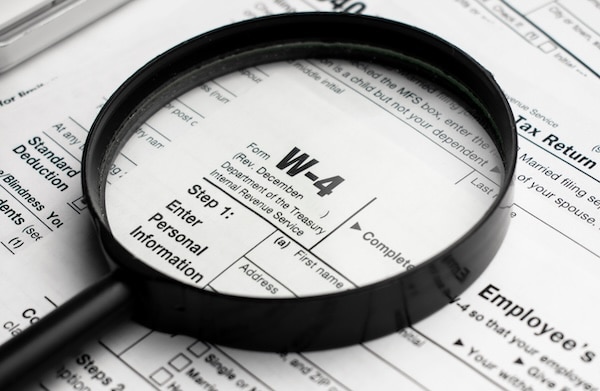Understanding Your W-4: The First Step to Smarter Paychecks

Starting a new job often comes with a flood of paperwork, and the W-4 form is usually near the top of the pile. It might look like just another tax document—but the choices you make here can impact your finances all year long.
Starting about the time of the Super Bowl, you see a lot of ads for “maximum tax refund”. In reality, the tax refund you receive is not determined by the tax preparer so much as your election on the W-4 form.
Income Tax Withholdings Explained
During the work year, employees pay an estimated amount of income tax each pay period. This is called ‘withholding tax’. The federal government (and some states) hold the withheld tax, and waits for you to file an income tax return the following year.
When you prepare your tax return:
- If your withholdings are more than the actual tax you owe – you get a refund.
- If your withholdings are less than the actual income tax you owe, you pay the difference between what is owed and what was withheld.
Tax returns must be filed no later than April 15th each year for the previous year.
Let’s break down the W-4, so you can make confident, informed choices from Day One.
What’s the W-4, and Why Does It Matter?
The W-4 tells your employer how much federal income tax to withhold from your paycheck. You don’t specify an actual number. Rather, the amount withheld is based on a few factors. First, is your level of income. This is important, because tax rates are based on income levels. The second key factor is the number of dependents you claim on your W-4 form. The more dependents you claim, the less income tax is withheld. Why? Because dependents are allowances for deductions from income tax. Those key factors determine how much gets pre-paid or “withheld” throughout the year.
The goal? To avoid owing a big chunk of money come tax season—and maybe even land a refund. So, you should aim to have enough withholdings to cover your actual tax bill.
How Employers Use It
Your employer uses your W-4 to calculate withholdings, so they can input the amount of payroll deductions. Again, If too little is withheld, you could owe taxes (and possibly penalties). If too much is withheld, you’ll get a refund. While refunds are nice surprises, a downside to having too much withheld is you’ll see less ‘take home’ pay each paycheck.
Preston’s Practical Advice
If you’re not sure where to start, a simple approach is to write “0” on Line H of the form. This means you are claiming zero dependents and generally results in the maximum tax withholding, which means you’re more likely to get a refund when you file.
For most employees, especially early in their careers, that refund can serve as an involuntary savings account, financial cushion or emergency fund starter.
Of course, if you’d rather have more take-home pay now and don’t mind a smaller (or zero) refund later, you can increase your allowances or use the IRS estimator tool (found by clicking here) to customize your entries.
Looking at lower tax withholdings/the opposite perspective, so ask “why would I give a zero percent interest loan to the government?” This is a very reasonable question and the mathematically correct answer is to keep as much of your cash under your control. However, the behavioral reality is that most people (often including myself) don’t have the discipline to set aside the cash in a high yield savings in anticipation of owing the government money.
There are scenarios where it does make sense for highly sophisticated/disciplined people to manage their cash and pay the tax bill later.
Why This Matters
Many people treat the W-4 as a “set it and forget it” form—but it pays to understand how your elections impact your paycheck and your tax return. Adjustments can be made any time during the year, especially if you:
- Get a raise
- Pick up a second job
- Have a major life change (get married, have a baby, etc.)
Final Thought
Filling out your W-4 might seem like a small step, but it’s your first move toward financial control at your new job. Make it count.
At Dealing With Debt, we believe that clarity and confidence are your best financial allies. That’s why we offer expert guidance, supportive community tools, and down-to-earth advice to help you reduce stress and build a more stable future—one paycheck (and budget) at a time.
Next up: “Choosing a Healthcare Plan: Making the Right Call for Your Health (and Wallet)”






Responses